| The Abyss - Part III - Jellies and Ctenophores |
| Written by Jonathan C. Wojcik - Photo credits unknown or from public news articles unless otherwise noted. If you know their sources and need them credited or removed, please e-mail me. |
| The Comb Jellies |
One of the oddest of the ctenophores has yet to be classified or even named, but lives at
greater depths than any other species known to science. It is not known what this mystery
animal preys upon, but it attaches itself to the sea floor by a set of long, thin tentacles and
drifts like a kite in the water's current. Actually captured by remote video in 2002, the
footage went unnoticed until April of 2006.
greater depths than any other species known to science. It is not known what this mystery
animal preys upon, but it attaches itself to the sea floor by a set of long, thin tentacles and
drifts like a kite in the water's current. Actually captured by remote video in 2002, the
footage went unnoticed until April of 2006.
As with most of the natural world, vertebrates make up only a fraction of the animal life in the abyss.
I've discussed many of its Cephalopod species here, and other weird organisms here, but have
yet to address the wide diversity of is squishiest, gooiest inhabitants...
I've discussed many of its Cephalopod species here, and other weird organisms here, but have
yet to address the wide diversity of is squishiest, gooiest inhabitants...

Nearly all species possess rows of tiny, rippling cilia that propel them through
the water, the "combs" of their namesake. None bear a venomous sting, but
many are armed with tentacles coated in "lasso cells;" microscopic bags of
sticky thread that explode when touched. Others, like the Beroes comb
above, simply use their gaping mouth to engulf prey.
the water, the "combs" of their namesake. None bear a venomous sting, but
many are armed with tentacles coated in "lasso cells;" microscopic bags of
sticky thread that explode when touched. Others, like the Beroes comb
above, simply use their gaping mouth to engulf prey.
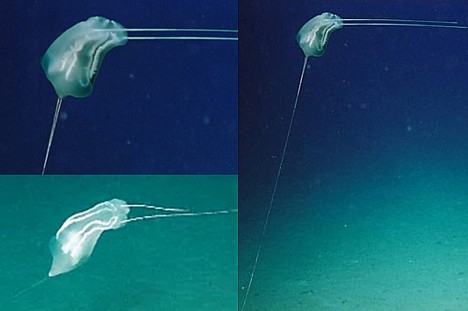
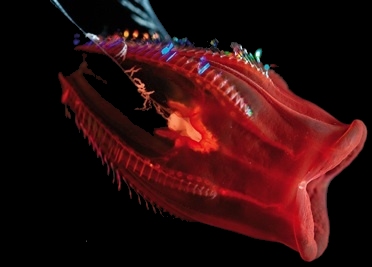
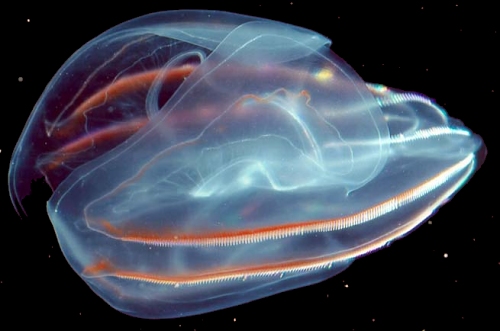
| Jellyfish |
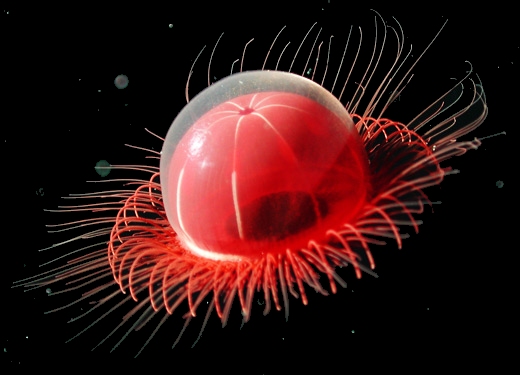
Proper Cnidaria are certainly no strangers to the abyss, the only place they may manage to
look even more like martian spacecraft. Though many produce light, their reasons for doing
so are poorly understood. Some species seem to emit brilliant flashes when disturbed,
more than likely a defensive reaction, while some are even thought to use light as a toxicity
warning. Many are a deep red in color, which appears virtually invisible to most abyssal fish.
look even more like martian spacecraft. Though many produce light, their reasons for doing
so are poorly understood. Some species seem to emit brilliant flashes when disturbed,
more than likely a defensive reaction, while some are even thought to use light as a toxicity
warning. Many are a deep red in color, which appears virtually invisible to most abyssal fish.
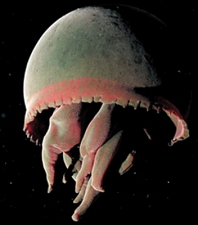
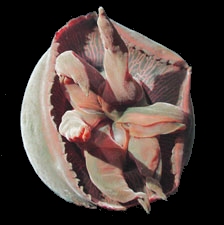
One such "cloaked" jelly is Tiburonia granrojo, first announced in 2003 and previously only
known as the "big red." Up to three feet across, it is among the world's bulkiest jellies and
peculiar for having only thick, fleshy arms with no tentacles to speak of.
known as the "big red." Up to three feet across, it is among the world's bulkiest jellies and
peculiar for having only thick, fleshy arms with no tentacles to speak of.
| Siphonophores |

Other deep-sea Siphonophores prefer a more sedentary lifestyle, anchoring themselves
by long, thin stalks. One such variety resembles a giant, writhing dandelion, and can be
found growing near boiling hot, highly toxic hydrothermal vents.
by long, thin stalks. One such variety resembles a giant, writhing dandelion, and can be
found growing near boiling hot, highly toxic hydrothermal vents.
Related to the jellyfish and corals, the beautiful and alien Siphonophore is actually
a continuous chain of specialized polyps - individual animals that grow from one
another in an organized colony. Some in the colony are devoted to feeding, armed
with stinging cells to snag fish or invertebrates. Others are devoted to locomotion,
propelling the whole group with a continuous pumping motion. Still others, of
course, exist only to reproduce.
Some species are considered the longest animals in the world, forming chains that
can stretch over a hundred feet in length.
a continuous chain of specialized polyps - individual animals that grow from one
another in an organized colony. Some in the colony are devoted to feeding, armed
with stinging cells to snag fish or invertebrates. Others are devoted to locomotion,
propelling the whole group with a continuous pumping motion. Still others, of
course, exist only to reproduce.
Some species are considered the longest animals in the world, forming chains that
can stretch over a hundred feet in length.
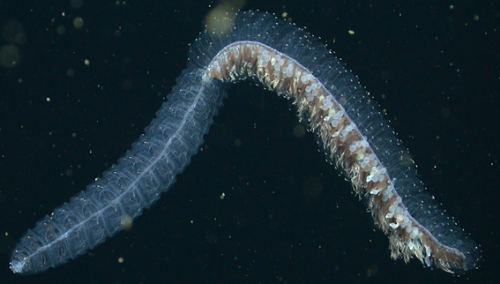
Most siphonores trail a long net of tentacles to capture their prey, but the
species above - another fairly recent discovery - attracts prey with luminescent
lures that imitate the motion of tiny shrimp. This is hardly an unusual behavior for
the deep as you are no doubt aware, but it is previously unheard of in brainless,
eyeless animals like the Cnidaria.
species above - another fairly recent discovery - attracts prey with luminescent
lures that imitate the motion of tiny shrimp. This is hardly an unusual behavior for
the deep as you are no doubt aware, but it is previously unheard of in brainless,
eyeless animals like the Cnidaria.
Among the deep's most plentiful inhabitants, comb jellies are not to be
confused with the jellyfish or other Cnidaria, but belong to their own distinct
phylum, the Ctenophora, considered one of the single oldest animal phyla on
Earth.
confused with the jellyfish or other Cnidaria, but belong to their own distinct
phylum, the Ctenophora, considered one of the single oldest animal phyla on
Earth.
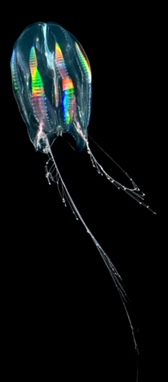

| Fly-trap Anemones |
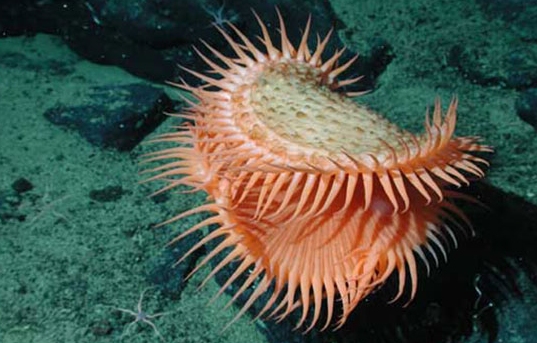
Yet another branch of the Cnidaria, the well-known sea anemones attach their stalked
bodies to rocks or other surfaces and wait for other creatures to simply blunder into
them, leaving all the work to their sticky, stinging tentacles. Since the chances of this
happening are slimmer in the wide, open abyss, one species has adapted a slightly
more aggressive approach; its uniquely folded body snaps shut instantaneously over
small animals, employing the tentacles more to corral the prey than to perform the
capturing itself.
Fly-trap anemones are capable of secreting a bioluminescent slime when agitated, but
it isn't currently known how this benefits the animal.
bodies to rocks or other surfaces and wait for other creatures to simply blunder into
them, leaving all the work to their sticky, stinging tentacles. Since the chances of this
happening are slimmer in the wide, open abyss, one species has adapted a slightly
more aggressive approach; its uniquely folded body snaps shut instantaneously over
small animals, employing the tentacles more to corral the prey than to perform the
capturing itself.
Fly-trap anemones are capable of secreting a bioluminescent slime when agitated, but
it isn't currently known how this benefits the animal.
| Above left: K. Raskoff / Monterey Peninsula College |
| Steven Haddock (c) 2004 MBARI |